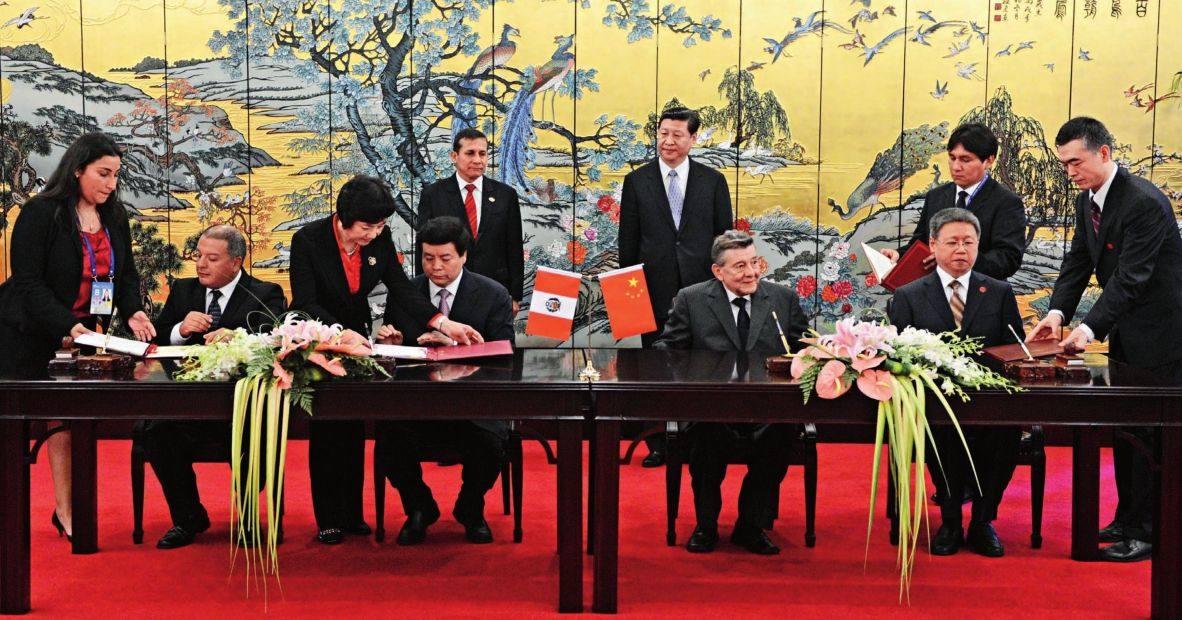Sharing the Chinese Dream with Latin American Countries
2013-04-29ByLUGUOZHENG
By LU GUOZHENG
WHEN Chinese President Xi J inping visited Latin American countries between May and J une this year, the phrase “Chinese Dream” was mentioned frequently by local leaders as well as the media. They believed that their countries can share the Chinese Dream and make joint efforts with China to achieve common development.
Growing Partnerships
Their opinions are based on hard facts. In the past 20 years, economic and trade relations between China and Latin America have enjoyed unprecedented development. China has established comprehensive strategic partnerships with most major countries in Latin America. To take Mexico as an example, the annual trade volume between China and Mexico was less than US $100 million between the late 1980s and early 1990s, while in 2013 the accumulated trade volume from J anuary to April reached US $11.4 billion. In 2012, the trade volume between China and Latin American and Caribbean countries was US$261.2 billion, an 8.7-fold increase compared with US $26.8 billion in 2003.
Rapid development of Sino-Latin American trade relations has brought enormous benefits for both sides. Without the abundant supply of raw materials from Latin America, China may have met unimaginable difficulties during its sustained and stable economic growth. Similarly, the Latin American economy, which has been growing at a higher rate than the world average and successfully handled the negative influence of the global financial crisis, benefits from Chinas economic growth.
The United Nations Economic Commission for Latin America and the Caribbean (known as ECLAC, or in Spanish CEPAL) was the first to realize this “secret.” For quite a long time, the United States was considered the only engine driving economic recovery and development in Latin America. However, since 2003, when a new period of economic growth in the region started, things have begun to change. In its 2005 annual report, CEPAL first named China as the second most important force boosting Latin American economic growth. After that, CEPAL started to attach increasing importance to Chinas role in the economic recovery and growth of Latin America and the Caribbean, and published articles refuting the ideas of “China threat” and Chinese neo-colonialism advocated by certain alternative media in some developed countries. As an influential international institution, CEPAL emphasized many times the importance of Latin American countries grasping the opportunity of Chinas development, strengthening bilateral cooperation with China, and achieving a mutually beneficial result. As time went by, the opinion and advice of CEPAL turned out to be more and more welcomed by Latin American countries. This is the deep-seated reason for the popularity of the “Chinese Dream” in Latin America.
Generally speaking, China, Latin America and the Caribbean enjoy a trade balance. But there still exist trade imbalances with some countries. In the past 20 years, China has reported high trade surplus with Mexico, for example. But this situation is not caused by Chinas trade policy; it was a result of the market supply-demand relationship and the industrial structure of Mexico. Due to their trade deficit, the corresponding Mexican industries faced high competition, and thus started an anti-dumping investigation and import limitations on some Chinese products. But the anti-dumping measures are not the key to the problem. They have not stopped the momentum of Sino-Mexican trade growth and have failed to effectively protect the complainant industries. Instead, the measures have harmed the interests of Mexican consumers. Even if Chinese products are forced out of Mexico, the market vacuum can be immediately filled by products from other Asian countries. By then the Mexican industries will still face a fierce market competition, and inflation could become an additional cause of concern for the country.
Trade and Investment
There are at least two proactive methods to reduce the trade imbalance. The first is to expand Mexicos exports to China. The two countries, geographically separated by the immense Pacific Ocean, need to advance mutual understanding as well as deepen and widen areas for economic and trade cooperation. In 2003, Mexico held a large-scale exhibition in Beijing, during which I served as an interpreter. This exhibition presented the industrial and agricultural development of Mexico and made quite an impression on the Chinese audience. But at that time, Chinas economy was stagnant and the level of foreign trade was low, so there was not enough foreign exchange to consider trade in Mexican products. Over the following decade, little was heard of Mexico holding such fairs in China again. Nowadays, big cities in China host large-scale expositions every year and Mexican entrepreneurs can participate to exhibit and sell their products at a relatively low cost.
Moreover, new markets of trade in services can be explored. For example, the abundant tourism resources in Mexico are very valuable for the tourism industry. In recent years, the number of Chinas outbound tourists has witnessed astonishing growth. In 2009, the number of Chinese tourists was 47 million, despite the global financial crisis. In 2012 the number increased to 77 million, and in 2013 it is expected to exceed 100 million. Island chains like the Maldives in the Indian Ocean are one of the favorite destinations of Chinese tourists. Cancún and other Mexican resorts could be similarly attractive to Chinese holidaymakers. But they are not well-known enough in the Chinese market and there is currently no airline that conveniently covers the long haul from China to Mexico. If countries like Mexico, Brazil and Argentina could devote stronger efforts to publicizing the beauty of their homelands, I am sure the heads of Chinese tourists would soon turn. If the number of passengers wanting to travel from China to Mexico were to increase, the problem regarding the air route will need to be solved to meet the demand. Whats more, the budding airline business is sure to boost the development of infrastructure and the growth of the service industry. This model of development has proved to be successful in countries of South east Asia, Europe and Oceania.

The second method is to expand mutual investment between the two sides. In China, there are already some investment projects from countries like Mexico, Brazil and Argentina; the total investment from China to Latin America has reached US $65 billion. These mutual investments have created many jobs for both parties. However, this is far from sufficient when compared with the economic scale of both China and Latin America. To take the investment from China to Latin America as an example, this is currently limited to mineral resources and energy industries. In the past 30 years, China has made great progress in building infrastructure such as roads, ports and high-speed rail networks. China has accumulated rich experience and technology appropriate for developing countries, which can be shared with Latin American countries.
Sino-Mexican Free Trade Area (FTA)
Prior to President Xi J inpings visit to Latin America, some journalists asked him about the signing of a Free Trade Agreement between China and Mexico. He responded that China has signed such an agreement with three Latin American countries: Chile, Peru and Costa Rica. China has also officially started a joint feasibility study on a free trade zone with Colombia. If the Mexican side shows willingness to negotiate with the Chinese side on establishing a free trade zone, China is ready to strengthen cooperation with Mexico in this respect.
Establishing FTAs is an astute move to deepen the comprehensive strategic partnership between China and Latin American countries. As pioneers among the developing countries in practicing the idea of free trade zones, Mexico, Chile and other Latin American countries have made outstanding contributions to promoting regional economic integration and global trade and investment liberalization, and have provided rich experience for other developing countries, including China, to follow suit. China has learnt a lot from the FTA negotiations with Chile, which in turn promoted the smooth establishment of FTAs with Peru and Costa Rica.
In the early 1990s, Mexico negotiated with the United States and Canada to join the North American Free Trade Agreement, an act that showed great foresight and courage. Although there were voices of dissent at the time, this decision proved to be the right strategic move. With the global trend of establishing free trade zones, China and Mexico, the mutual strategic partners across the Pacific Ocean, must now race against time to add the establishment of a free trade zone to the schedule. This process requires both sides to be innovative. The first step could be encouraging a non-official feasibility study on a free trade zone between China and Mexico. Both countries need to work hard to create favorable conditions to launch governmental negotiation in this respect.
There is no doubt that with the establishment of a free trade zone, Mexican products would become much more competitive in Chinas market thanks to the tariff reduction and exemption. Consequently, Mexicos trade deficits in goods would be largely reduced. In addition, the well-developed manufacturing industry and service industry in Mexico, including banking and insurance, could enjoy a better future in Chinas market by taking advantage of the FTAs favorable conditions. At the same time, Mexico will be able to attract more Chinese capital, share Chinas technology and experience in leading fields, create more job opportunities, and benefit its own people. The establishment of a Sino-Mexican free trade zone will certainly be a new model of South-South cooperation around the world.
The global financial crisis, already into its fifth year, may draw to a close. China and Latin America are experiencing an important period of strategic opportunities. We should grasp this chance and share the “Chinese Dream” with Latin America. This effort will boost the healthy and smooth development of the bilateral relationship and create a bright future right before us.
